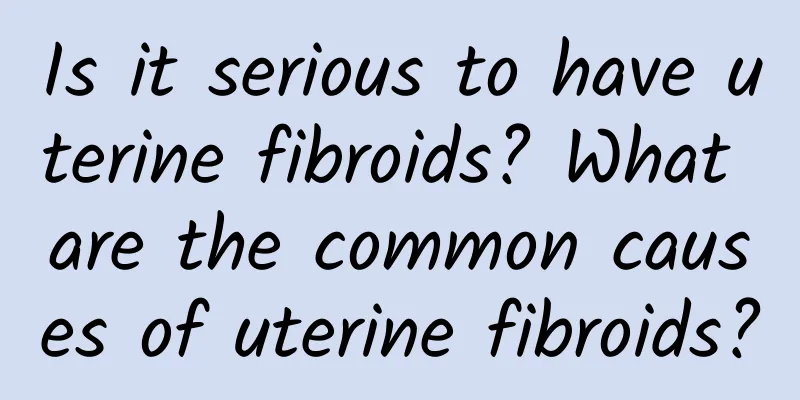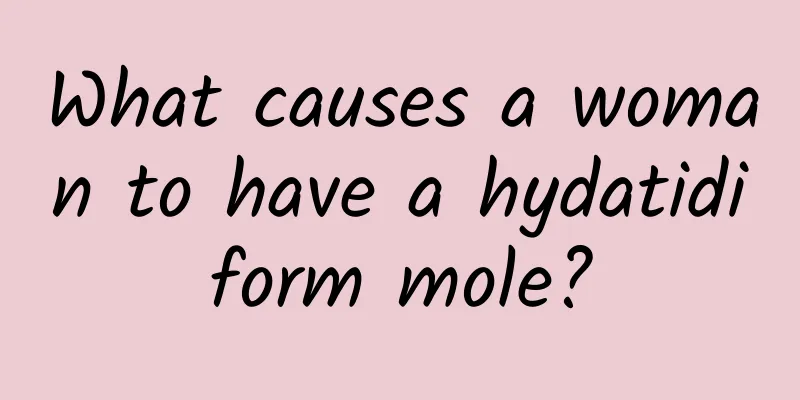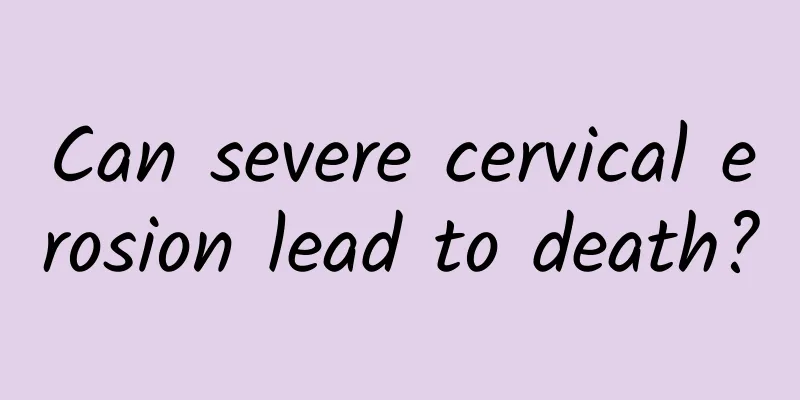Is it serious to have uterine fibroids? What are the common causes of uterine fibroids?

|
Uterine fibroids: (Hysteromyoma), uterine leiomyoma, also known as uterine leiomyoma, is the most common benign tumor of the female genitalia. Most of them are asymptomatic, and a few show vaginal bleeding, abdominal tumors and compression symptoms. If the pedicle is twisted or other conditions occur, it may cause pain. It is common in multiple uterine fibroids. The exact cause of this disease is unknown, and it may be related to excessive estrogen levels in the body and long-term estrogen stimulation. Modern Western medicine uses sex hormones or surgery for treatment, and there is no other ideal treatment method. Causes of uterine fibroids 1. Endocrine: If women take their own vegetarian medicines or some skin beauty products into the uterus for a long time, it will lead to an increase in estrogen levels, thus causing uterine fibroids. 2. Unhygienic sexual life: Unhygienic sexual life can cause vaginitis, cervicitis, cervical erosion and other reproductive organ infections. 3. Age: Benign tumors mostly occur in women of childbearing age, malignant tumors mostly occur in elderly women, and a few special types of tumors mostly occur in adolescent and teenage women. 4. Fertility: Fertility factors such as premature delivery, dense birth, and multiple births. In addition, estrogen levels increase during pregnancy and fibroids increase rapidly. 5. Long-term spasm: The uterus is in a state of tension for a long time, causing the uterine wall muscle fibers to react and produce uterine fibroids. Symptoms of uterine fibroids 1. Excessive menstrual bleeding: As uterine fibroids grow slowly, the volume of the uterus also slowly expands, and the area of the endometrium also increases accordingly. At the same time, because the tumor in the uterus affects the hemostatic function of menstruation, patients often have heavy menstrual flow, long or short menstrual periods, or even intermittent or continuous bleeding. If the patient bleeds too much or the menstrual period is too long, it can lead to hemorrhagic anemia. 2. Dysmenorrhea: When uterine fibroids are compressed, the uterus will contract and the endometrium will have ectopic symptoms. Therefore, women with uterine fibroids often have menstrual pain. 3. Excessive leucorrhea: The occurrence of uterine fibroids can cause pelvic congestion and infection in patients, leading to increased vaginal discharge and excessive leucorrhea, sometimes with pus and a special fishy smell. 4. Lower abdominal mass: As uterine fibroids grow larger, patients will feel the mass during the examination, especially before urinating after getting up in the morning. This is because the bladder is very full and the uterus moves upward, so it is easier to touch the fibroids. 5. Compression symptoms: When uterine fibroids become larger, the bladder, rectum and peripheral nerves will be compressed, so the patient will experience low back pain, constipation and frequent urination. 6. Infertility: Generally speaking, women with uterine fibroids are not easy to get pregnant. Even if they get pregnant, they are prone to miscarriage and premature birth, and the fetus develops slowly in the uterus, resulting in stillbirth. If the fibroids grow in the lower part of the uterus, it will cause dystocia when it is obvious, and it will also cause uterine atrophy and weakness, prolong the production process, and eventually cause heavy bleeding after delivery. The harm of uterine fibroids 1. Infertility or miscarriage. Uterine fibroids can cause the uterine horn fibroids to compress the entrance of the fallopian tube, which can hinder the implantation of the fertilized egg and eventually lead to infertility. In addition, according to statistics, the spontaneous abortion rate of fibroid patients is also higher than that of ordinary people, with a ratio of 4:1. 2. Malignant lesions. Uterine fibroids are benign tumors, but a small number of women still cannot escape the risk of malignant transformation, which is particularly prominent in elderly women. Therefore, patients with rapidly growing fibroids or postmenopausal fibroids should remain vigilant. 3. Infection and suppuration. Uterine fibroids can cause pelvic congestion and infection. The infection is mainly caused by tumor pedicle torsion, while blood infection is extremely rare. After infection, a few patients develop abscesses in the tumor tissue, while the rest develop suppurative ulcers. 4. Secondary anemia. Uterine fibroids can cause excessive menstrual bleeding. Over time, it can lead to secondary anemia and even anemic heart disease. In severe cases, patients will experience adverse symptoms such as general fatigue, pale complexion, palpitations, and shortness of breath. Common treatments for uterine fibroids 1. Ultrasound therapy. Ultrasound therapy is a new treatment method that focuses on the treatment area, causing the cell proteins in the treatment area to coagulate and necrotize, gradually shrinking the tumor. 2. Drug treatment. This treatment is the most ideal treatment for patients, because after curettage to exclude endometrial cancer, it is treated with a combination of Chinese and Western medicine, but it is recommended because the side effects of Chinese and Western hormone treatment are large. 3. Minimally invasive treatment. Minimally invasive surgery is mainly laparoscopic treatment, which makes up for the shortcomings of traditional treatment methods and surgical treatment, and can make patients recover as soon as possible. At the same time, the risk of surgical treatment is relatively reduced. Because it is a minimally invasive surgery, the wound is very small, which can satisfy women's love of beauty. 4. Expectant treatment. For women who are close to menopause, whose fibroids grow slowly, whose uterus is smaller than that of a 3-month pregnancy, and who have no menorrhagia or compression symptoms, they only need to be checked every 3 to 6 months, hoping that the uterine fibroids will shrink after menopause. Prevention and care of uterine fibroids 1. Maintain a normal diet, eat on time and in the right amount. Sudden overeating can easily cause metabolic disorders. 2. Try to eat less greasy food and insist on eating more fish, eggs, vegetables and fruits. Eat peanuts, melon seeds, sesame seeds, etc. regularly. These dried fruits are rich in nutrients. 4. Soybeans can regulate hormones in the body, and eating more soy products can maintain endocrine balance. Eat less spicy, fried and grilled foods, and don't smoke or drink. |
<<: Who are the high-risk groups for uterine fibroids? What should I do if I have uterine fibroids?
>>: Is it serious to have uterine fibroids? What are uterine fibroids?
Recommend
What medicine should I take for a uterine fibroid that is more than one centimeter in size? Can a uterine fibroid that is 1 cm in size be eliminated by taking medicine?
Uterine fibroids are common benign tumors in wome...
What are the main causes of vulvar leukoplakia?
What are the main causes of vulvar leukoplakia? P...
What are the symptoms of congenital absence of vagina?
What are the symptoms of congenital absence of va...
What are the dangers of medical abortion?
For female friends who are short of pregnancy and...
Cooling cucumber sandwiches with tea
On a hot summer day, the most enjoyable thing to ...
Vegetable, fruit and flower tea, healthy New Year dishes, low-calorie, high-fiber, real oil cut
Fried, boiled, stir-fried and deep-fried fish and...
Treatment methods for uterine fibroids High-risk groups for uterine fibroids
Uterine fibroids are a common female disease. Now...
General treatment of pelvic peritonitis
Pelvic peritonitis is a common disease, and the p...
Experts reveal: Causes of ectopic pregnancy
As a relatively serious female disease, ectopic p...
It is not advisable to take motherwort granules for more than a few days after a miscarriage
How many days after miscarriage should you not ta...
Doctors challenge fat guy to lose weight! The doctor lost 17 kg, and the patient lost 20 kg, getting rid of the threat of severe fatty liver
Mr. Cai, 33, who lives in Taichung, has to social...
The third leading cause of death among women: diabetes! Get moving to control blood sugar 5+5!
If you want to maintain a slim figure but are too...
Who says you can only eat boiled meals to lose weight! Teach you how to make sesame oil and black fungus chicken breast, low fat, nutritious and good with rice
【Aijia Ancient Flavor】—Sesame Oil and Black Fungu...
Experts please tell us about the complications of abortion
There are many things that patients who have unde...
Analyze the multifaceted causes of clinical pelvic inflammatory disease
In recent years, the incidence of pelvic inflamma...









